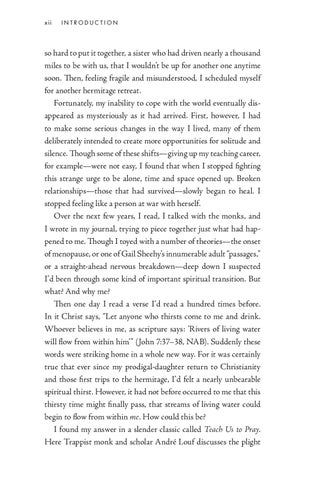x ii
introduction
so hard to put it together, a sister who had driven nearly a thousand miles to be with us, that I wouldn’t be up for another one anytime soon. Then, feeling fragile and misunderstood, I scheduled myself for another hermitage retreat. Fortunately, my inability to cope with the world eventually disappeared as mysteriously as it had arrived. First, however, I had to make some serious changes in the way I lived, many of them deliberately intended to create more opportunities for solitude and silence. Though some of these shifts—giving up my teaching career, for example—were not easy, I found that when I stopped fighting this strange urge to be alone, time and space opened up. Broken relationships—those that had survived—slowly began to heal. I stopped feeling like a person at war with herself. Over the next few years, I read, I talked with the monks, and I wrote in my journal, trying to piece together just what had happened to me. Though I toyed with a number of theories—the onset of menopause, or one of Gail Sheehy’s innumerable adult “passages,” or a straight-ahead nervous breakdown—deep down I suspected I’d been through some kind of important spiritual transition. But what? And why me? Then one day I read a verse I’d read a hundred times before. In it Christ says, “Let anyone who thirsts come to me and drink. Whoever believes in me, as scripture says: ‘Rivers of living water will flow from within him’ ” (John 7:37–38, NAB). Suddenly these words were striking home in a whole new way. For it was certainly true that ever since my prodigal-daughter return to Christianity and those first trips to the hermitage, I’d felt a nearly unbearable spiritual thirst. However, it had not before occurred to me that this thirsty time might finally pass, that streams of living water could begin to flow from within me. How could this be? I found my answer in a slender classic called Teach Us to Pray. Here Trappist monk and scholar André Louf discusses the plight
